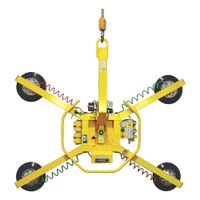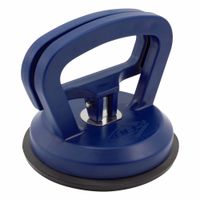Call +(254) 703 030 000 / 751 483 999 / 721 704 777
- Home
- Material Handling
- Lifting Pulling Positioning
- Suction Lifters
.....Read More
Frequently Asked Questions
What are suction lifters used for?
Suction lifters, also known as suction cups or vacuum lifters, are tools used to handle, lift, and move materials with smooth, non-porous surfaces. They operate by creating a vacuum between the suction pad and the surface of the object, allowing for a secure grip. These devices are commonly used in various industries for different applications:
1. **Glass Handling**: Suction lifters are extensively used in the glass industry to handle glass panes, windows, and mirrors. They provide a safe and efficient way to move fragile glass without causing damage.
2. **Construction**: In construction, suction lifters are used to lift and position large tiles, stone slabs, and metal sheets. They help in reducing manual labor and increasing precision during installation.
3. **Manufacturing**: In manufacturing settings, suction lifters assist in the assembly line processes by moving components and finished products. They are particularly useful for handling large, flat items like panels and boards.
4. **Automotive Industry**: Suction lifters are used in the automotive industry for installing windshields and other glass components. They ensure a secure hold and precise placement during installation.
5. **Warehousing and Logistics**: In warehouses, suction lifters help in the handling and transportation of goods, especially those that are heavy or awkwardly shaped, improving efficiency and safety.
6. **Home Use**: Smaller suction lifters are available for domestic use, such as moving furniture, lifting heavy appliances, or even as temporary handles for bathroom safety.
Overall, suction lifters enhance safety, efficiency, and precision in handling tasks, reducing the risk of injury and damage to materials.
How do suction lifters work?
Suction lifters, also known as suction cups or vacuum lifters, operate based on the principle of creating a vacuum between the lifter and the surface of the object being lifted. They consist of a handle attached to one or more rubber or plastic cups. When the cups are pressed against a smooth, non-porous surface, air is expelled from the space between the cup and the surface.
The key to their operation is the creation of a partial vacuum. This is achieved by either manually pressing the cup against the surface or using a mechanical or electric pump to remove air. The reduction in air pressure inside the cup compared to the atmospheric pressure outside creates a strong suction force. This force holds the cup firmly against the surface, allowing the object to be lifted and moved.
The effectiveness of a suction lifter depends on several factors: the smoothness and cleanliness of the surface, the material and condition of the suction cup, and the strength of the vacuum created. Suction lifters are commonly used for handling glass, tiles, metal sheets, and other smooth materials. They are available in various designs, including single-cup, double-cup, and multi-cup configurations, to accommodate different weights and sizes of objects.
To release the object, the vacuum is broken by either lifting a release tab on the cup or using a valve to allow air back into the space between the cup and the surface. This equalizes the pressure and releases the suction grip, allowing the object to be safely set down.
What are the different types of suction lifters?
Suction lifters, also known as vacuum lifters, are devices used to handle and transport materials with smooth, non-porous surfaces. They come in various types, each suited for specific applications:
1. **Manual Suction Lifters**: These are handheld devices with one or more suction cups. They are operated manually and are ideal for small-scale tasks like lifting glass panes, tiles, or other flat materials. They are portable and easy to use.
2. **Electric Suction Lifters**: Powered by electricity, these lifters provide a stronger and more consistent suction force. They are suitable for heavier loads and are often used in industrial settings for lifting large glass panels, metal sheets, or stone slabs.
3. **Pneumatic Suction Lifters**: These use compressed air to create a vacuum. They are highly efficient and can handle heavy and large materials. Pneumatic lifters are commonly used in manufacturing and construction industries.
4. **Battery-Powered Suction Lifters**: These offer the mobility of manual lifters with the power of electric ones. They are cordless, making them versatile for use in areas without easy access to power sources.
5. **Hydraulic Suction Lifters**: These are used for extremely heavy loads. They combine hydraulic systems with suction technology to lift and move large and heavy objects safely.
6. **Specialized Suction Lifters**: Designed for specific applications, such as curved surfaces or materials with slight porosity. They may have adjustable suction cups or additional features to accommodate unique shapes and textures.
Each type of suction lifter is designed to meet specific needs, balancing factors like load capacity, mobility, and power source to ensure safe and efficient material handling.
How do you maintain suction lifters?
To maintain suction lifters effectively, follow these steps:
1. **Regular Inspection**: Frequently check the lifter for any signs of wear, damage, or deterioration. Pay special attention to the suction pads, seals, and any moving parts.
2. **Cleanliness**: Keep the suction pads clean and free from dust, dirt, and debris. Use a mild detergent and a soft cloth to clean the pads, ensuring they maintain their grip.
3. **Seal Integrity**: Inspect the seals for cracks or wear. Replace any damaged seals immediately to prevent loss of suction.
4. **Lubrication**: Regularly lubricate moving parts as per the manufacturer's recommendations to ensure smooth operation and prevent rust.
5. **Vacuum System Check**: Test the vacuum system regularly to ensure it maintains the required suction level. Check for leaks in hoses and connections.
6. **Storage**: Store suction lifters in a clean, dry place away from direct sunlight and extreme temperatures to prevent material degradation.
7. **Load Capacity**: Always adhere to the manufacturer's specified load capacity. Overloading can damage the lifter and compromise safety.
8. **Training**: Ensure that all operators are properly trained in the use and maintenance of suction lifters to prevent misuse and accidents.
9. **Documentation**: Keep a maintenance log to track inspections, repairs, and replacements. This helps in identifying patterns and planning preventive maintenance.
10. **Manufacturer Guidelines**: Follow the manufacturer's maintenance guidelines and schedule for specific instructions related to your model.
By adhering to these maintenance practices, you can extend the lifespan of suction lifters, ensure safety, and maintain optimal performance.
What is the weight capacity of suction lifters?
The weight capacity of suction lifters varies significantly depending on their design, size, and intended use. Generally, suction lifters, also known as suction cups or vacuum lifters, are used to handle materials like glass, metal, plastic, and other non-porous surfaces. The capacity can range from a few kilograms to several tons.
1. **Small Suction Lifters**: These are typically used for manual handling tasks and can have a weight capacity ranging from 5 kg to 100 kg. They are often used in applications like lifting small glass panes or tiles.
2. **Medium Suction Lifters**: These are more robust and can handle weights between 100 kg and 500 kg. They are suitable for larger glass panels, metal sheets, or similar materials.
3. **Large Suction Lifters**: These are often used in industrial settings and can have capacities from 500 kg to several tons. They are used for heavy-duty applications such as lifting large glass panels in construction or moving heavy metal sheets in manufacturing.
4. **Specialized Suction Lifters**: Some suction lifters are designed for specific applications and can have customized weight capacities. For example, vacuum lifters used in the automotive industry for handling car body panels may have different specifications.
The actual weight capacity also depends on factors such as the number of suction cups used, the vacuum level achieved, the surface condition of the material being lifted, and the safety factors applied by manufacturers. It is crucial to follow the manufacturer's guidelines and safety instructions to ensure safe operation.
Are suction lifters safe to use?
Suction lifters, also known as suction cups or vacuum lifters, are generally safe to use when proper guidelines and precautions are followed. They are designed to handle smooth, non-porous surfaces like glass, metal, and certain plastics, making them ideal for lifting and moving heavy or awkward objects without causing damage.
Key safety considerations include:
1. **Surface Compatibility**: Ensure the surface is clean, dry, and non-porous. Suction lifters are ineffective on rough, dirty, or porous surfaces, which can lead to slippage.
2. **Weight Capacity**: Adhere to the manufacturer's specified weight limits. Overloading can cause the suction to fail, leading to accidents.
3. **Inspection and Maintenance**: Regularly inspect the suction lifters for wear and tear, such as cracks or deformities in the rubber cups. Replace any damaged parts immediately to maintain safety.
4. **Proper Use**: Follow the manufacturer's instructions for attaching and releasing the suction lifter. Ensure a secure seal by pressing firmly and checking for air leaks.
5. **Environmental Conditions**: Be cautious in extreme temperatures or wet conditions, as these can affect the suction power and reliability.
6. **Training**: Users should be trained in the correct handling and operation of suction lifters to prevent misuse and accidents.
7. **Backup Safety Measures**: In critical applications, consider using additional safety measures, such as straps or secondary supports, to prevent accidents in case of suction failure.
By adhering to these guidelines, suction lifters can be a safe and effective tool for lifting and transporting heavy materials. However, neglecting these precautions can lead to accidents, injuries, or damage to the materials being handled.
How do you choose the right suction lifter for a job?
To choose the right suction lifter for a job, consider the following factors:
1. **Load Capacity**: Determine the weight of the object to be lifted. Choose a suction lifter with a capacity that exceeds this weight to ensure safety and efficiency.
2. **Surface Material**: Identify the material of the object. Suction lifters work best on smooth, non-porous surfaces like glass, metal, or polished stone. For rough or porous surfaces, specialized lifters with enhanced suction capabilities are required.
3. **Surface Condition**: Assess the condition of the surface. Clean, dry, and flat surfaces provide optimal suction. If the surface is dirty or uneven, it may compromise the lifter's grip.
4. **Number of Cups**: Consider the number of suction cups needed. Larger or heavier objects may require multiple cups to distribute the load evenly and provide stability.
5. **Cup Material**: Choose the appropriate cup material. Rubber cups are versatile, while silicone or other specialized materials may be needed for high-temperature or specific chemical environments.
6. **Handle Design**: Evaluate the handle design for ergonomics and ease of use. Handles should provide a comfortable grip and allow for easy maneuverability.
7. **Vacuum Generation**: Decide between manual or powered vacuum generation. Manual lifters are suitable for lighter loads, while powered options are better for heavy or frequent lifting tasks.
8. **Safety Features**: Look for safety features such as vacuum gauges, warning indicators, or automatic release mechanisms to prevent accidents.
9. **Regulatory Compliance**: Ensure the lifter complies with relevant safety standards and regulations for your industry or region.
10. **Cost and Brand Reputation**: Consider the cost relative to your budget and the reputation of the manufacturer for reliability and customer support.
By evaluating these factors, you can select a suction lifter that meets the specific requirements of your job, ensuring safety and efficiency.




